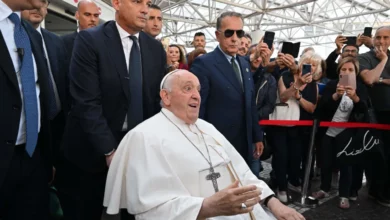
Slain Salvadoran archbishop Oscar Romero and Pope Paul VI, Catholic giants who sparked controversy during their lifetimes, will join the church’s highest rank Sunday with an elevation to sainthood.
Pope Francis will wear a blood-stained rope belt which belonged to Romero, who was murdered at the altar, as he leads the ceremony in front of some 60,000 pilgrims and heads of state from across the world.
The pontiff will also use a chalice and pastoral staff belonging to Paul VI in a canonization being seen as a reminder of Francis’s call for “a poor church for the poor”.
Both men have been hailed by Francis for their courage in turbulent times and their dedication to social justice and the downtrodden.
Their giant portraits were unfurled on Saint Peter’s Basilica along with those of five other new saints, including an orphaned youth and a German nun.
Romero stood up for peasant rights in the face of a right-wing backlash which painted him as a radical supporter of “liberation” theology in his small, impoverished central American nation.
His radio sermons condemning government repression came to be heard throughout the land.
On March 24, 1980, the man dubbed the “voice of those without voice” was shot in the heart, killed by a single bullet as he prepared communion at the start of a bloody civil war which claimed some 75,000 lives.
‘Gave his life’
Overnight hundreds of pilgrims from across Central America celebrated the impending canonization in El Salvador’s capital.
The visitors, many in clothes printed with Romero’s face, gathered in front of his tomb, in the crypt of San Salvador’s central cathedral, and at the Hospital of Divine Providence chapel, where he was assassinated.
“We are arriving here to honor the memory of Monsignor Romero, who took his faith to the point of giving his life for what he believed was right,” said Francisco Navarro, a 51-year-old Honduran, at the chapel along with some 30 of his compatriots.
“Since before he was killed, he defeated his killers by forgiving them. Because he knew they were going to kill him,” added university professor Julia Lainez.
For a long time, efforts to recognize Romero met with heavy opposition from conservative Catholics and the Salvadoran right, who saw veiled Marxism in his sermons.
Others said he had been killed for political rather than religious reasons and therefore should not be considered a Catholic martyr.
“It was like a dagger to the heart. I received threats,” Archbishop Vincenzo Paglia, the man tasked with guiding the canonization process, told the Jesuit weekly America.
But Francis — the first Latin American pope — beatified him as a “martyr” in 2015 to popular acclaim after his predecessor, the retired Benedict XVI, championed his cause for canonization.
It was Benedict who also extolled Paul VI, a man he once described as “almost superhuman”.
Paul VI — who encouraged Romero in his struggle — was the first head of the Roman Catholic Church to attempt to reform the Vatican’s powerful and unruly Curia, a challenge Francis also decided to take on.
He was also famously the first to reject the papal trappings of luxury, setting aside the traditional papal tiara — a jewel-encrusted, three-tiered, conical crown — shortly after his election in 1963 and donating its value to the poor. It was a gesture echoed by Francis, who renounced the papal apartment and gold cross.
‘Brave Christian’
The softly-spoken Giovanni Battista Montini was elected pope in 1963 in a difficult period for the church, which lost many believers as populist rebellions swept across the West.
He completed the reforms of the Second Vatican Council and was the first pilgrim pope, crossing continents on his trips to meet the faithful.
At his beatification mass, Francis had hailed him a “brave Christian”.
But he was also hampered by a reputation for being weak and overly cautious.
He is most famous for reaffirming the church’s ban on contraception — despite the fact that his own advisory commission voted overwhelming to lift the prohibition.
The decision enraged many Catholics at a time of sexual freedoms, with women demanding the right to use the birth control pill.




